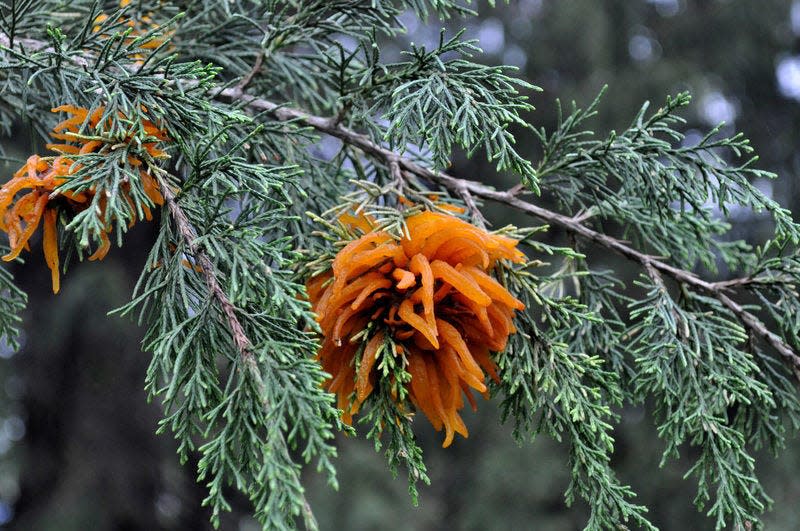Which springtime tree diseases require treatment? Here are some to look for

Our often-wet springs bring with them the perfect conditions for many plant diseases. While moist weather can create conditions for diseases on many plants, sick trees in the landscape tend to draw our attention.
Knowing the signs of common tree diseases can help you determine whether your help is needed or if the tree can manage the disease on its own.
Anthracnose
Anthracnose is a fungal disease favored by cool, wet weather that can affect sycamore, oak, maple and many other shade trees. Younger leaves may turn black and wither while older leaves have brown areas following the major veins of the leaf.
Leaves dropping from the tree is common, and at a glance these leaves may appear to be completely healthy (no brown or black spots) as the petiole of the leaf is sometimes the only affected part.
In 2017, anthracnose was so severe on our sycamore trees that many homeowners reported trees that lost all their leaves.
Fortunately, these trees will make a complete recovery. After a few weeks, the tree will leaf out again with no long-term effects on the tree’s health. Fungicides, often thought to cure anthracnose, do nothing.
Give your tree time to recover on its own, no treatment necessary.
Peach Leaf Curl and Plum Pocket
Peach Leaf Curl is a fungal disease that causes developing peach leaves to become puckered and distorted and show a reddish-green hue.
A similar disease called plum pocket may develop on American and sand hill plums. Plum pocket results in formation of distorted, light green, bladder-shaped fruit.
Although these diseases become visible on our peach trees in the spring, the treatment window is fall, after leaf drop through early spring, before bud swell.
An effective fungicide is chlorothalonil (Bravo, Daconil, Fertilome Broad-Spectrum Fungicide, Ortho Garden Disease Control and others). Be sure to cover the entire tree, including the bark and trunk.
Trees already affected this year may lose a substantial amount of leaves. Fruits of affected trees should be thinned significantly, and the tree should be fertilized in accordance with a soil test. Both efforts help the tree to put on a new flush of growth for the year.
Brown rot of stone fruits
Brown rot appears in the formation of gray to brown, fuzzy growth on the fruit of our peaches, plums, apricots and other stone fruit. As a result, the fruit may rot in as little as a day or two.
Treatment should start a month before fruit harvest. That time will vary depending on your fruit type and variety, so pay careful attention to the harvest time for your tree.
Any fruit that shows symptoms cannot be saved but should be destroyed to prevent further spread.
Captan or myclobutanil (Immunox or F-Stop Lawn & Garden Fungicide) should be used for control. Apply either Captan or myclobutanil every seven to 14 days. Both products can be applied up to the day of harvest.
Cedar apple rust and cedar hawthorn rust
Cedar apple rust is a disease with two hosts, juniper and apple.
A similar disease, cedar-hawthorn rust, also affects pears at the same time, although the organisms are completely different.
On the juniper trees, cedar apple rust appears as alien-like orange glob with gelatinous tentacles.
On pear and apple, the two rusts' appearances are much less dramatic. Yellow-orange spots on the leaves grow larger and brighter orange as the summer progresses.

For juniper and pear, damage is only aesthetic and control is optional.
If you do wish to control rust on pears, fungicides must be sprayed in April or May, when the fungus is active.
Specifically look for products with the active ingredient myclobutanil (Immunox, Immunox Plus, or Fertilome F-Stop Lawn & Garden Spray).
Other products are effective for cedar hawthorn rust, but products with myclobutanil will kill the rust up to four days after it germinates, while other products must be applied before it is active.
A key indication for when to spray pears is to look for the bright orange galls on your or your neighbors’ juniper trees. Although the gall is technically a different disease, the conditions that favor both diseases are the same.
When you see the gall, spray your pears with a product containing myclobutanil.
Apple trees with cedar apple rust may affect fruit quality and overall tree health as the disease can cause repeated defoliation.
For apples, products containing myclobutanil are also effective, beginning in April and ending in May. A spreader-sticker can be added to the fungicide mixture to improve the distribution and retention of the pest control chemicals over the leaves and fruit.
Sprays are applied every 10 to 14 days. A hard, driving rain of about one inch or more will likely wash chemicals from the leaves and fruit. In such cases, another application should be made.
As always, when using chemicals, read and follow the label exactly. Proper timing and correct chemical selection are key to control. Contact the Shawnee County Extension Office for assistance identifying specific issues with your tree and creating an effective management plan.
Ariel Whitely-Noll is the horticulture agent for Shawnee County Research and Extension. She can be reached at arielw@ksu.edu.
This article originally appeared on Topeka Capital-Journal: Watch for these spring tree diseases. Some may require treatment.

